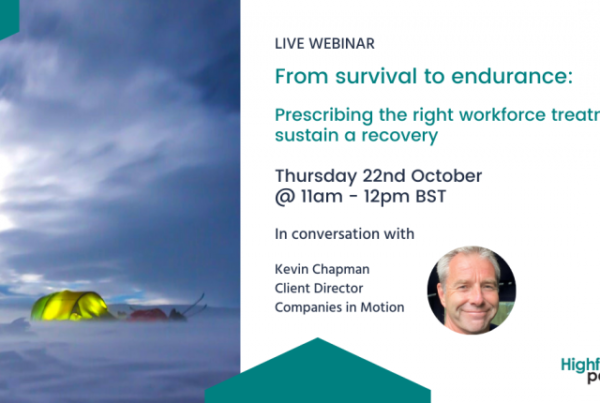
There are plenty of webinars on the subject of Equality, Diversity and Inclusion, all with their merit and espousing best practise theory, but quite often I find they may lack a practical, relatable edge to your everyday business. With this in mind I recently hosted a roundtable discussion to consider the theme of ‘Taking ED&I up a gear in company hiring’. I was eager to include participants from wide ranging organisations, at different stages on this journey, but nonetheless sharing a common thread of playing an instrumental role to help their businesses make an intentional step change on ED&I in relation to their company hiring efforts.
So for those who are keen to take strides, but don’t necessarily know where to start or what to focus on, this will hopefully give either the seeds inspiration, or actual practical advice that can be replicated and customised in your own business.
We were delighted to host this roundtable session including those from HR to Business Operations, with blue chip to smaller company experiences to share, and operating in the commercial sector and non-profit worlds, giving us a wonderfully diverse mix around the table!
Here is a summary of the themes that emerged from those who’ve been successfully taking these strides.
Be clear on your reasons for taking action in the first place
This sounds very obvious, but it’s nonetheless an aspect where firms can go wrong. As with any business strategy, unless you’ve been really clear on the rationale in the first place, it’s unlikely to produce any meaningful impact. ED&I is perhaps one of those areas where firms feel they should be taking action, normally with the best of intentions, and they rush to think about ‘the how’ they’re going to intervene to bring about change, but fail to contemplate ‘the why’. As a result ‘the what’ (action is taken) may well lack the intended impact to make a lasting and tangible positive difference, and end up being a scattergun to-do list without any cohension. For example, if you set off to change the gender balance of your business because you know it’s lop-sided, but fail to interrogate the existing patterns around your organisational demography, or those of your external audience, it may bring about greater top-line gender balance, but perhaps not in areas that will result in the positive business impact you wanted.
So, a clear aim on what change you’re looking to make, and why, is an imperative step. Is it to stimulate greater business innovation, or improve performance in some aspect? Are you trying to better represent the local area or customers you provide a service or offering to? Are there problems with scaling or growing as a result of an inability to find the right talent for your business?
Amongst the experiences shared in the group discussion referred exactly to this point. It was the industry tendency to be looking at the headline figures such as gender and ethnicity, so the inputs tended to be focused on hiring more in those under-represented categories as a short-term fix, but without tackling the endemic situation, such as whether the business culture would allow this talent to flourish and feel included. So true progress wasn’t going to be made. It wasn’t until the business brought in an external perspective that they really began their meaningful journey with a much clearer set of objectives. Which leads to the next point….
Look to the external world
An extremely important point was raised in the group, that a successful strategy around ED&I should not rest on an individuals’ shoulders. Often this will be handed to the HR Director, and it can be a solitary position to be in. Not only will you not have all the answers, but also ED&I invariably needs a shift that will be organisationally wide, and an HRD alone can’t make that impact.
Support can come in many shapes and forms, however. With the example above, it was through bringing in external D&I experts, to facilitate discussions, that the re-set of the strategy could begin, not least as it started with the executive team. Working with an external facilitator supported the process to identify a glut of actionable items to address, and helped the business build a workable plan for itself.
Reaching out with professional networks can also be invaluable. Even within the session we hosted with relative D&I ‘subject expertise’ around the virtual table, it was evident that many in the group were spotting opportunities to learn from others as we spoke. Using LinkedIn or professional groups is a great way to source insight, but remembering that not everyone will be willing to share delicate information about their employers publicly, so engaging in verbal dialogue is an alternative to hear more ‘off the record’ intelligence.
Getting an external view can be immensely important to get things going in the right direction, but also continuously improving along the way. Ultimately though, taking a leap forward in ED&I in your hiring will rely on your ability to get the internal audience pulling in the same direction.
Creating internal advocacy
This is a matter of educating the hiring community, not just equipping them with the tools and skills they’ll need, but gaining their advocacy on ED&I.
With the best of intentions it’s possible to put in place a whole host of initiatives to diversify your workforce, but if the culture hasn’t changed to make those from diverse backgrounds feel truly included, then it’s going to all be for nothing – an attraction problem will simply become a retention problem.
Although it is a wider point around ED&I strategy, engaging everyone in an organisation in more open dialogue around ED&I themes is central to effective hiring as well. Discussing privilege, fostering allyship, creating an inclusive culture, these will all be fundamental to move the dial to build a more diverse workforce as it feeds heavily into the hiring process. This lies with educating the workforce, raising the level of advocacy amongst the hiring community, as the more they recognise the importance of an inclusive, fair, consistent hiring process, the stronger results it will produce.
One example given was the creation of an ‘Inclusive Hiring Charter’ designed to elevate levels of good practise around ED&I company wide, such as mandating an independent panellist at final interview stage and promoting gender balanced interview panels, advertising salary ranges. Any such initiative requires ongoing efforts to make it leave and breathe in an organisation though, and be supported by strong training provision. It did set the tone on expectations, with clearly defined and communicated messages, acting as a central and accessible forum to embed good practice in day to day hiring.
In essence, the key point raised was the importance to practise what was preached, creating an authentic welcoming environment where those from diverse backgrounds felt they belonged.
So what tips on attracting more diverse talent then?
You have to be pro-active to engage with diverse talent pools
There are a lot of specialised job boards stressing their diversity specialism, and these certainly have a role to play. However, whilst acknowledging their merits, most in the group felt they achieved much stronger results to attract from diverse talent pools by taking more proactive steps than simply placing a job ad.
This isn’t a case of one size fits all, but really boils down to taking the time to seek out new channels to promote your company as an employer of choice, and then taking assured steps to build these connections.
For example, it could be the choice of school or college you make to partner to open doors to work experience or apprenticeships. One firm in attendance was partnering a particular school that had higher rates of under-privileged children, even though they weren’t the most local school they could have elected to partner. The same applies to working with charities/partners, selecting those that may more closely reflect the areas where your business is under-represented.
Another example we heard of was to partner with a firm called Bright Network and rather than spending their budget on advertising on the normal channels, they allocated it to creating an event with a Black Heritage Forum, the result was a markedly improved shift to attract relevant applications from talent pools they would otherwise not have accessed.
Seeking out and building connections with individuals or networks with whom you may otherwise be unable to attract, and trying out different channels to reach new audiences, it all takes a bit of effort, but the results will normally pay off handsomely if given the right time and thought.
De-bias with actions not words
Unsurprisingly we spoke at some length around de-biasing your hiring process, quite often a pivotal point to create a fairer and more inclusive hiring experience. There are plenty of tools and technologies to support with this, such as CV redaction, but several in the group had referred to successful methods to assess to help mitigate bias in the assessment process.
The shift towards using practical assessment seemed to have very positive results in some circumstances. For example setting tasks to create work samples to show capability as an alternative to asking interview questions based on past experience. This proved particularly successful to bring those with more diverse backgrounds through processes where they may otherwise have never got beyond screening stages. Strengths based assessment to focus on what the candidate can do, rather than what they’ve done was a theme that a number seemed to acknowledge as a positive move to remove biases around people’s career or academic background. One case study also included running a completely anonymised process for a senior hire, with applicants providing detailed answers to ten carefully constructed questions, determining who’d be shortlisted for the final stage interview – no CV’s, no pre-interviews.
We all have our biases, and it’s likely these can appear in an interview process. Another interesting initiative we heard about was interviewers having pre- and post-interview meetings to discuss any biases each participant may have, so collectively the panel can help mitigate bias adversely impacting the objective assessment of each candidate. Perhaps this would be something initially to be facilitated by the HR team initially, but quickly interview panels were running independently with this and finding it a helpful forum, as well as promoting the collective spirit to talk openly on the subject of ED&I and understand others’ perspectives.
Dig down on data
As with most business strategies, data is integral. Linking back to the first segment to make sure you know what you’re trying to achieve, digging down on data is extremely important. In some cases the relevant data may not be in plentiful supply, and obtaining demographic data may be easier to obtain through hiring processes than your existing workforce.
It was pointed out that data can be interpreted in different ways, so it’s important to drill down to truly understand how best to act. For example, in a large global firm, a blanket one size fits all to drive consistency may not be the right way to go – what works globally may be inappropriate in-country. In one company the top-line showed a gender imbalance in the organisation, but to ask the hiring manager to take target hiring more white females to their team when that’s what they exclusively have already, won’t be successful to get the hiring manager on board with ED&I!
There are many ways in which data can take your ED&I in hiring up a level though. Knowing what demographic you have, and what you’re attracting, and then measuring changes after the action has been taken. Are there any demographic trends emerging from the selection process? For example can drop out rates at certain stages shed light on your preferred method of assessment. Research shows live video interviewing carries a proportionately higher drop out rate from those of lower socio-economic status for example. If you know about it, you can act upon it, as one firm did by introducing mentoring between existing employees and applicants during selection processes to help the applicants perform at their best during the process.
Root out assumption to overcome diverse talent vacuums
Whether it’s in technology, academia, professional services or engineering, many recruiters will have been confronted with a hiring manager that’s got a pre-set idea of what background they’re looking for. Perhaps they’ll have a legitimate point, but challenging assumptions can be important to take strides to overcome blockers to diversifying your workforce.
There are many instances where the established institutional system creates pockets of severe inadequacy in the supply of diverse talent. Females in STEM is perhaps the most obvious, black leaders in academia, lower socio-economic backgrounds in professional services, and many more. I recently saw a thread about a firm insisting on having Russell Group university backgrounds, whereas one in the group successfully changed the dial hiring to early career tech roles in exactly this respect, with positive business results. When they ran their early career intake assessments using more equitable processes they saw a dramatic surge in non-Russell Group joiners who met the grade more quickly, because they found ‘traditional’ universities had not been preparing students with skills suited to the world of work.
If the institutional system has created these pockets where hiring a ready-to-go candidate from a diverse background is in scant supply, then re-examining the essentials of what you need to do the role is key, and then opening the door to those who could display the necessary levels of capability needs to follow. Schemes such as Disability Confident Employers is one such example, where is someone meets the minimum criteria, they will be considered for assessment.
It may take a little more time, and require a little more challenge, but the best things are worth preserving with!
And one last thing
I struggled to categorise all the points from our session so neatly, so here are some of the final pieces of wisdom to emerge from this group discussion!
Perfection can be the enemy to progress. Sometimes it’s worth just starting the journey rather than bottoming everything out at the beginning. Take a pragmatic view, everyone is learning!
The language you use IS important on your adverts, so take a little extra time to make sure it’s going to attract the audience you’re looking to engage with. It’s also worth noting that within your adverts, or on your career sites, it can be instructive for prospective applicants to see your commitment and credentials to redress areas of under-representation.
I’d personally like to thank all those who attended the roundtable, it was a great forum for discussion, and as we saw it was too big a subject to tackle in just an hour! However, some invaluable insights from those who are walking the walk, which I hope will prove useful to many others seriously committed to the same journey.
Here are some links to service providers or information sources that cropped up during our discussions and may be worth checking out.
https://www.brightnetwork.co.uk/
https://disabilityconfident.campaign.gov.uk/




